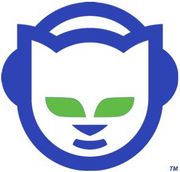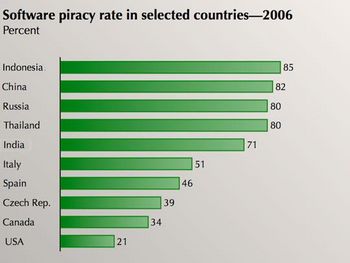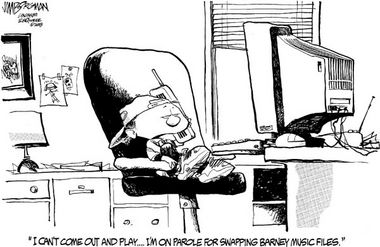Arr Matey: Multimedia Piracy on the Internet
Contents
Team Information
Team Members
- John Bodzioch
- Lee Fladhamer
- Zoya Konoff
- Adrianna Long
- Kimi Randhawa
Project Statement and Technology
Project Statement: Downloads and the file sharing of music, movies and television shows have become extremely common in today’s society. They're convenient and most importantly to many, they're free. However, the fact remains that in many countries, these practices are prohibited by law and considered copyright infringement. So, is there a justification to illegal downloading of entertainment, or is it a practice that we should really try to stop?
Technology Primarily Examined: Peer-to-Peer (P2P) File Sharing
What is Piracy?
At first thought of the word Piracy, many people think of pirates; ruthless men upon the high seas in search of treasures and glory by any means necessary. Individuals who will pillage and plunder from whoever may cross there path, taking whatever they can. Taken from this concept of thievery, the term piracy has been applied to other aspects of society, most notable computer and software piracy. Although the acts of piracy dealing with computers is not with the theft of computers as a whole, it is considerately more centralized with the programs, software and data that is stored within the computers.
While pirates have been roaming across the oceans ever since waterways have been used to transport supplies from one place to another with the earliest recorded acts of piracy taking place in the 13th century BC, computer and software piracy did not become 'popular' until the late 1980's when computers became more simplified.
Peer to Peer file sharing
What is it?
Peer-to-peer networks (P2P) are networks that use diverse connectivity and cumulative bandwidth, rather than the traditionally based medium of using servers. File sharing is the sending and receiving of files over a network. So, P2P file sharing is basically file sharing over P2P networks. What makes it different is that generally there is no uploading required for a client. This makes it more convenient for the user to share files with other users.
History of P2P File Sharing
Originally, files were shared using a server-client relationship. The system would control the amount of traffic among its users. A user would send a request to the system, and then the server would send back a list of peers that could be used for downloading. This system was quick and efficient, however if the server wasn’t properly maintained, there would be a tendency for broken links and out of date information. Furthermore, due to the nature of the system (there was only a single point of entry), the entire network was liable to collapse if on of the servers went down.
P2P file sharing became mainstream with the creation of Napster in 1999. Napster allowed individuals to download their favourite artists with no charge attached. However, its popularity also brought the issue of music piracy to the forefront of public attention. After various lawsuits from various companies Napster shut its doors in 2001 (it was later resurrected as an i-Tunes like entity). However, this was far from the end of file sharing.
The problems of Napster prompted some individuals to create a network without a centralized indexed server that had been used in the past. This meant that no centralized server was utilized to keep track of files. What happened instead was the computer would search a network for another computer that was using the same file sharing software that it was. Once it locates another computer, the second computer will then proceed to connect to the original computer. Once the connection is established, the user is then free to browse through the directories of the other computers to find the file that they’re looking for. Once they locate the file that they want, a direct connection will be opened, and the file will be free to download.
Recently, a third kind of P2P system has been designed: the anonymous P2P Network. These make use of anonymous routing to make it difficult to identify the senders and receivers of files. This allows for individuals to share various items without fear of being identified. However, this is still quite uncommon, due to being a relatively new technology, and decentralized and centralized file sharing networks are sill far more common.
Commonly Used Peer to Peer Software and Brief Descriptions
There are a wide variety of P2P networks available on the Internet. Here are some of the more popular ones.
- Limewire: Follows a decentralized file sharing system. Claims to be one of the fastest file sharing programs. However, like many file sharing systems, it comes with its fair share of bugs. Used to share a wide variety of different items.
- BitTorrent: A P2P network which relies primarily on using Internet search engines and index files through a series of data called “torrents”. Primarily used in the transfer of movies and television shows.
- WinMX: An older file-sharing network that is centrally based.
- Kazaa: This software had been considered to be one of the most popular file sharing systems ever. However, it is also riddled with adware, which has caused its popularity to decline in recent years.
- Morpheus: A P2P client that has both a free and a paid version to it.
Argument
For Piracy
Personally downloading music and other software is very convenient when surfing the web. It is also very beneficial because there is no cost involved. It is expensive to go to the store to purchase music as compared to just staying at home and downloading it for free. In this time era it seems like everyone participates or has participated in some form of piracy which makes everything okay because the majority of people lead the way. It is justifiable when everybody partakes in an illegal activity like piracy.
Piracy is positive for the rapid development in new technology to protect companies and large corporations from getting pirated. Many people are losing millions of dollars from illegal downloads so the companies are putting out more money to find ways to stop piracy. The positive side is an increase in wages, highly educated people, and advancement in technology.
Against Piracy
Piracy is the unauthorized use or reproduction of copyrighted or patented material. Illegally Downloading music, movies, and software is identical to stealing. Piracy robs hard working individuals who spend their time and money producing entertainment and computer programs for us to enjoy. Not only is this ethically wrong but it also leads to serious economic consequences.Piracy has encouraged people to cross moral boundaries, in which they would normally never even consider, and has contributed the slower development of companies and countries alike.
- Software Piracy: A study funded by the BSA(Business Software Alliance) covering over 70 countires showed that countries are potentially losing billions of dollars due to software piracy. According to the study if worldwide software piracy would be reduced by 10 percent then 2.4 million jobs could be created and almost $400 billion dollars would be generate in economic growth.
- Music Piracy: A study released by the IPI(Institute for Policy Innovation) shows that music piracy costs the industry $12.5 billion dollars annually, and is costing Americans 71,000 jobs.
- Music Piracy: According to an investigation done by Twentieth Century Fox most illegal recordings are taking place in Montreal movie theaters, and about 50% of the worlds pirated movies come from Canada. The film industry is considering delaying the release of new Movies in Canada, Which would frustrate consumers and hurt the movie industry.
Anti Piracy Laws and Consequences
Draconian Anti-Piracy Law
Canada is assumed the leading country in implementing piracy and copyright infringement crimes. The federal government has consistently been pressured by neighbouring countries, especially the United States, to take action against those who take advantage of the poorly developed anti-piracy laws in Canada. As of June 2008, the Draconian Anti-Piracy Law took effect. Bill C-61 outlines the major aspects of this law as follows:
Limitation (1) If a copyright owner has made an election under subsection (1), a defendant who is an individual is liable for statutory damages of $500.00 in respect of all the defendant's infringements that were done for the defendant's private purposes and that are involved in the proceedings.
Circumvention of Technological Measure (3.1) Every person, except a person who is acting on behalf of a library, archive or museum or an educational institution, is guilty of an of fence who knowingly and for commercial purposes contravenes section 4.1 and is liable.
- (a) On conviction on indictment, to a fine not exceeding $1,000,000.00 or to imprisonment for a term not exceeding five years or to both; or
- (b) On summary conviction, to a fine not exceeding $25,000.00 or to imprisonment for a term not exceeding six months or to both.
Which actions are considered illegal?
Many individuals today are still unaware of what is considered illegal in situations regarding piracy and/or copyright infringement. The following are just a few examples of what can be considered illegal in Canada regarding this subject:
- making any unauthorized copies (burning music, movies, television shows to a CD-R or DVD-R)
- selling, hiring, or distributing unauthorized copies through an enterprise or through the internet.
- being in possession of unauthorized copies with an intent of hiring, selling or distributing to others.
- publishing another person's work or ideas under your authority and name (much like plagiarism)
- illegally distributing unauthorized copies of software, books, music, games or movies impacting a legal entity's business.
Consequences of Piracy/Copyright Infringement
In Canada, if one is accused of copyright piracy or trademark counterfeiting they are guilty of an Intellectual Property (IP) Crime. Penalties and consequences regarding this crime do vary on the seriousness of the action, much like any other crime committed. Some penalties under the Copyright Act include:
- Maximum $1,000,000.00 fine and five years in prison.
- Minimum $500.00 fine
Conclusion
While piracy may be convenient and free, it's wrong and illegal. Each year, millions of dollars are lost from various industries because of piracy. However, this doesn't mean that people are going to stop doing it. As long as the perceived benefits obtained from piracy continue to outweigh the negatives outcomes of fines and jail, people will continue to do it. What we as individuals should do is think about who it is that piracy really hurts.
References
Kimi Randhawa
- 1)Draconian Anti Piracy Law
- http://torrentfreak.com/canada-proposes-draconian-anti-piracy-law-080612/
- 2)Intellectual Property Crime
- http://www.rcmp-grc.gc.ca/fio/intellectual_e.htm
- 3)Which Actions are Illegal?
- http://en.wikipedia.org/wiki/Copyright_infringement
John Bodzioch
- 1)Wired News Report: OK, OK, Maybe Piracy Is Bad
http://www.wired.com/techbiz/media/news/2005/12/69785
- 2)Rosalind Blanchard, piracy
http://whatis.techtarget.com/definition/0,,sid9_gci213592,00.html
- 3)Music piracy costs $12.5 billion U.S. and 71,000 lost jobs every year
- 4)Vito Pilieci, 50% movie piracy from Canada: Hollywood
http://www.canada.com/globaltv/national/story.html?id=b3dea202-82da-4ad9-b6f8-277923bc1f6b
- 5) Eric Bangeman, BSA Piracy economic impact is tens of billions of dollars
- 6)Washington Post
http://www.washingtonpost.com/wpdyn/content/article/2006/09/28/AR2006092801640.html
- 7)Crime and criminal justice statistics
- 8)The True Cost of Music Piracy
- 9)Piracy Worldwide
- 10)Software Piracy
Lee Fladhamer
Expert analysis
MIT Piracy Raid
Piracy sweep
Ukraine Piracy
Anti piracy
Piracy in Bolivia
Piracy superhighway
Copyright infringement
Computer Overview
India Crackdown
Zoya Konoff
- 1) Canadian Intellectual Property Office
- http://www.cipo.ic.gc.ca/epic/site/cipointernet-internetopic.nsf/en/Home#5 Retrieved on 2008-11-15
- 2) Grossman, Lev “The Battle over Music Piracy”
- http://www.time.com/time/magazine/article/0,9171,1625209,00.html Retrieved on 2008-11-15
- 3) Globe and Mail: “Music Piracy continues to Rise: Survey”
- http://www.theglobeandmail.com/servlet/story/RTGAM.20070730.wgtpiracy30/BNStory/Technology/home Retrieved on 2008-11-15
- 4) Film and Music Piracy: DirectGovUK
- http://www.direct.gov.uk/en/YoungPeople/CrimeAndJustice/TypesOfCrime/DG_10027978 Retrieved on 2008-11-15
- 5) Understanding peer-to-peer networking and file sharing
- http://www.limewire.com/about/p2p.php Retrieved on 2008-11-15
- 6) The Local: Young Voters Back File Sharing
- "http://www.thelocal.se/article.php?ID=4014&date=20060608 Retrieved on 2008-11-15
- 7) Top 10 Free File Sharing Programs
- http://compnetworking.about.com/od/p2ppeertopeer/tp/p2pfilesharing.htm Retrieved on 2008-11-15
- 8) A Little History on Music Piracy
- http://www.musicbizadvice.com/a_little_history_on_music_piracy%20.htm Retrieved on 2008-11-16
- 9) Who Piracy Hurts
- http://www.mpaa.org/piracy_WhoPiracyHurts.aspRetrieved on 2008-11-16
- 10) TV Torrents: When Piracy is Easier than Legal Purchase
- http://news.cnet.com/8301-13739_3-9775271-46.html Retrieved on 2008-11-16
- 11) Wikipedia: File Sharing in Canada
- http://en.wikipedia.org/wiki/File_sharing_in_Canada Retrieved on 2008-11-19
- 12) Wikipedia: Peer to Peer
- http://en.wikipedia.org/wiki/Peer-to-peer Retrieved on 2008-11-19
- 13) Wikipedia: Anonymous P2P
- http://en.wikipedia.org/wiki/Anonymous_P2P Retrieved on 2008-11-19
Image References:
- Napster Image: http://www.coadletter.com/article/borcon/files/3214/paper/3214.html
- Limewire Image: http://en.wikipedia.org/wiki/File:Limewire_logo.svg
- Piracy Graph: http://media.arstechnica.com/news.media/bsapiracy .jpg
- Pirates Image: http://i209.photobucket.com/albums/bb246/vebkumar/pirates .jpg
- Piracy Comic by Jim Borgman




